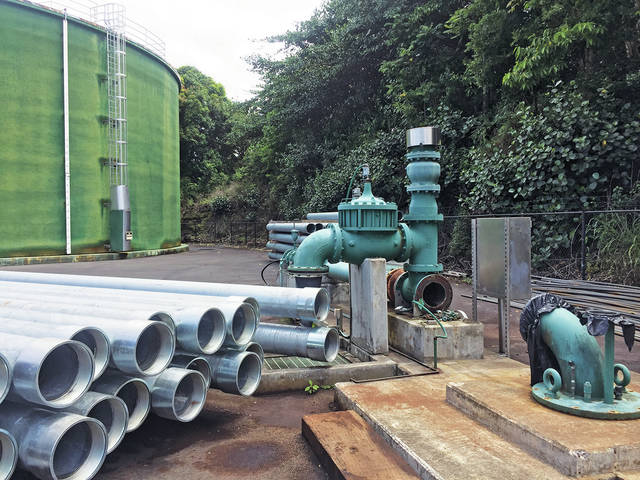KAILUA-KONA — Hawaii County Department of Water Supply has lost yet another water source in North Kona, prompting a revised water usage restriction with the most stringent mandates the department has issued since the saga began in January.
Civil Defense sent out a release Sunday morning indicating the Honokohau deep well is no longer in service. The problem is being assessed and no timetable has been set for well repairs.
The accompanying usage restriction includes an order that every customer in North Kona, including all businesses, may now only use water for the purposes of drinking, cooking and hygiene. All irrigation activities are prohibited.
It went on to explain that DWS has adjusted the water system, “…to provide customers a minimum level of water service,” but added that, “Without everyone’s cooperation, there will be areas that will experience periodic loss of water service or lower water pressures.”
DWS intends to suspend high usage accounts in the event they continue excessively using water, which is an indication to resorts and other large businesses that they should carefully monitor their usage rates.
The department added that it plans to suspend water to all temporary service and irrigation accounts.
Those who wish to obtain more information or report wasteful usage may contact DWS at 961-8060. Another line, 961-8790, is available for after-hours emergencies.
The Honokohau deep well is the fifth concurrently inoperative deep well in North Kona. There are a total of 13 water sources that supply the system.
It is the sixth North Kona well that has gone down at least once in the last year, though no more than five have been off line at any given time, and that only occurred once for roughly a week at the beginning of July.
It appears now that five water sources are likely to remain off line for at least a couple of months, which is the soonest any of the downed wells are scheduled to return to service.
That means the stringent water usage restrictions DWS issued Sunday is likely to remain in effect for an extended period of time, requiring more sacrifice and creating additional discomfort.
A water restriction has been in place since January, when DWS issued a mandatory 25 percent reduction across the board in North Kona. Irrigation has only been restricted once — for the aforementioned week at the beginning of July — when the recently repaired Keahuolu deep well faltered and brought the number of off line wells up to five.
Keahuolu was fixed quickly because spare parts were on hand, but that is not a typical scenario.
Manufacturers make deep well motors and pumps to order because of unique design requirements, and replacement parts often aren’t installed for at least six months after a failure.
The limitations on water usage now set by DWS are the harshest since North Kona’s water crisis began, and the department’s language in Sunday’s press release is as strong as it’s ever been.
DWS indicated an express intent to ration service to water usage abusers and overtly noted the very real possibility of discontinued service on a widespread basis in the face of noncompliance.
A contributing factor to the department’s heightened rhetoric and sense of urgency may have something to do with the nature of Honokohau deep well itself. DWS has in the past referred to it as the system’s “anchor well.” It has a capacity of 2 million gallons and services the heart of the water system.
Roughly 12 million gallons are pumped in North Kona on a daily basis.
The failure at Honokohau would not have created such dire circumstances had DWS been able to complete repairs to the Waiaha deep well, which has a capacity of 2 million gallons and was scheduled to return to service July 31.
The pump and motor were installed at Waiaha and tests were being run when the well tripped, indicating a problem with the equipment.
Derrick’s Well Drilling and Pump Services, the Big Island company contracted to run the installation, was hoisting the equipment out of the well at Waiaha when a cable snapped, sending everything plummeting back 1,700 feet below the ground.
Keith Okamoto, manager and chief engineer at DWS, said the pump and motor were almost certainly damaged in the accident.
However, as of the last communication with DWS, the equipment had not been inspected because it had yet to be retrieved. Thus, there is also no timetable for Waiaha’s return to service.
The problems at Keahuolu and Waiaha in July, and now at Honokohau in August are all part of a disconcerting trend — new deep well equipment failing far more quickly than it should.
New well equipment is supposed to have a lifespan of 5-7 years, but the Keahuolu deep well had been recently repaired before its failure on June 30.
And Okamoto said in a meeting with the County Council in mid-July that two of the four wells inoperable at that time had been repaired within six months before faltering again.
“We’re actually going to have a professional services contract come that will help us review … to see if there’s something that we’re missing,” Okamoto said.
“Six months is not acceptable.”
DWS has several contingencies in place, including the purchase of back-up equipment in advance for crucial wells.
The department identified Honokohau as one such crucial well. It’s unclear whether the process of ordering back-up parts for Honokohau had commenced before it faltered Sunday.
Repairs at three other wells currently down are set for completion respectively in late October, November and December.



